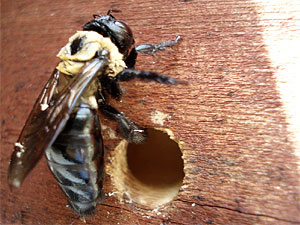Carpenter Bees and How to Deal With Them
How to Recognize Carpenter Bees
There are many species of carpenter bees, but they all present themselves in similar ways. Here are some of the tell-tale signs:
- Large, round bees buzzing around outside your home, often hovering around porches, decks, eaves, or anywhere else with exposed wood.
- Similar to bumblebees, they are usually black and yellow, but unlike bumblebees their abdomens are shiny instead of fuzzy.
- Approximately one-half inch round holes appear to be drilled into wood parts of your home. There may be sawdust-like or goopy material accumulating at the entrace of the hole or underneath it.
- Faint, buzzing, drilling-like sounds coming from the wood parts of your home.
About Carpenter Bees
The carpenter bee genus includes over 500 different species. Nearly all of them burrow into hard plant material like wood, hence their name. They are very similar in appearance to the bumblebee, an inch long and black and yellow in color. As touched on above, the best rule of thumb for distinguishing the two is to look at the abdomen – bumblebees are fuzzy, while carpenter bees are smooth. In many places carpenter bees are important pollinators. Their short mouthparts are especially helpful to shallow flowers, and a few species of plants may even rely on carpenter bees as their only pollication mechanism.
Of main concern to the homeowner is their burrowing behavior. In the spring, females bore approximately half-inch in diameter corridors into wood. These channels can be up to four feet long, though they are usually between one and two feet. They perform this feat by using their jaws. Contrary to what you might think, they don’t actually eat the wood. Instead they use the chewed wood pulp they generate to build walled chambers at the end of their burrow. Here she will lay her eggs, as well as a supply of nectar and pollen for them to feed upon when they hatch. At that point the female’s life ends, and by late summer or early fall the new generation will hatch, emerge to feed, then re-enter the hole to hibernate until the following spring.

How to Prevent Carpenter Bee Infestations
Preventing a carpenter bee infestation is generally easier than reacting to one. Here is what you can do:
- Paint or varnish unfinished wood to make it less attractive to carpenter bees.
- Use treated lumber, as it is less susceptible to damage from these insects.
- If it fits with your plans and aesthetic, consider a non-wood covering for areas that might be attractive to carpenter fees.
- Fill all cracks and holes before painting or sealing your wood, as these are often the kinds of places the bees like to start their tunnels.
- Spray vulnerable areas with an approved insecticide. Common choices include Cyzmic CS, FenvaStar EcoCap, and Demon WP. Note that some insecticides may require approval or a license in your area, so check with local regulations. The best time to start is spring, and you may need to retreat every couple months through the fall.
How to Get Rid of Carpenter Bees
What should you do if prevention failed and you already have an active infestation? Start with these actions:
- Use an insecticidal dust in the holes. Pump the powder into the opening as deep as you can – there are applicators available that may assist with this.
- Use a liquid treatment. Spray directly into the hole, again trying to get the liquid as deep as you can. Alternatively, fill the entrace hole with steel wool that has been dipped or sprayed with insecticide. With this method, the bees will need to chew threw the insecticide soaked steel wool before they can emerge.
- After the bees have been killed it is time to plug the existing holes. Use a plug or wooden dowel in combination with putty, glue, or caulking compound.
Note that all activity near the bees should be done during dark hours if possible, as the bees are less likely to be active during that time.

